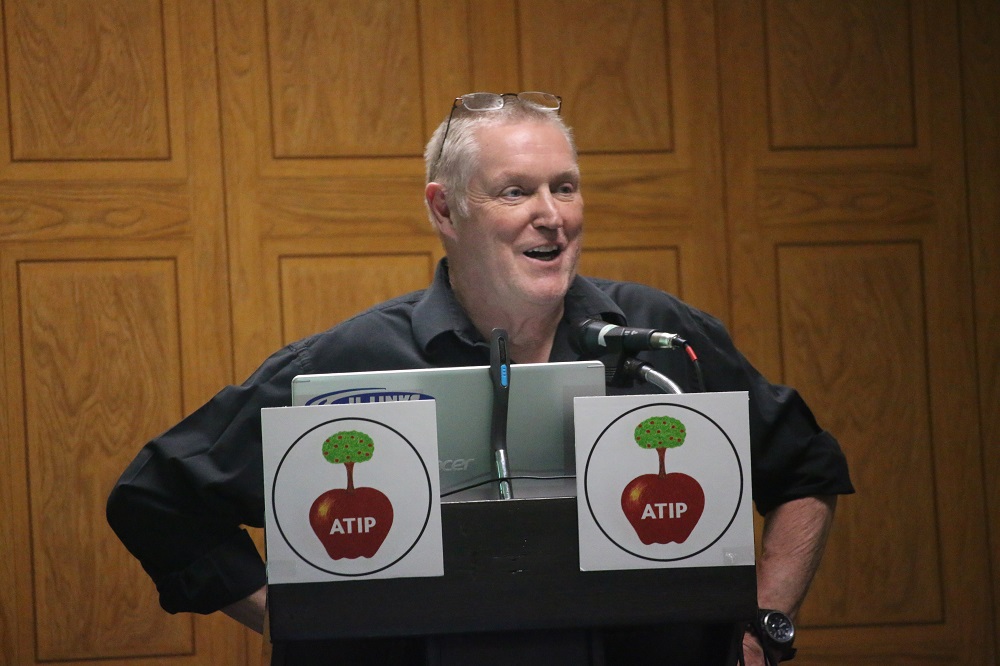Luba Cargill admitted she felt a little overwhelmed at times during last week’s All About Apple Trees symposium in Haliburton, but for all the right reasons.
The event was months in the making – a collaboration between Cargill and volunteers involved with her Apple Tree Identification Project (ATIP) and U-Links Centre for Community-Based Research. It brought some of the continent’s top apple experts to the Highlands, educating people about apple tree locations and apple-based operations in the County, and investigating the role apples can play in improving food security.
Around 100 people attended the two-day event, held at the Haliburton Legion May 16 and 17.
“It was an outstanding success – we covered a lot of topics in terms of apples, people were very receptive and eager to hear how they could help further promote the use of apples in the County, and all the wonderful benefits they bring,” Cargill said.
Celebrity apple tree hunter Tom Brown made the trip from North Carolina, keeping the crowd engaged while he retold stories of him discovering hundreds of different apple varieties over the years. Author Helen Humphries discussed her book The Ghost Orchard, later doing a reading and signing copies for fans.
Brian Husband, a University of Guelph professor, talked about the Ontario Heritage and Feral Apple Project. He said the fruit is native to Europe and Asia but can now be grown almost anywhere in the world. He studies feral populations that have sprouted in unusual areas, noting Haliburton County is home to several such locations.
Through her work with ATIP, Cargill has identified more than 170 apple tree locations across the County, including 10 orchards. Many are located on private acreages, and on municipal land – some long forgotten about, and evidence that early settlers relied on apples as a key food source, Cargill noted.
Given the County’s position as one of the poorest in Ontario – with around 17 per cent of residents living in poverty per the City of Kawartha Lakes Haliburton Poverty Reduction Roundtable – and an increased demand at all food banks, attendees heard how the fruit can play a key role in improving food security in the area.
Aisha Malik, co-chair of Harvest Haliburton, said her organization partnered with Abby Junkin, a research student from Trent University, on ways to maximize the County’s apple supply.
“We know there are challenges to our community when it comes to growing local food. There are geographical constraints, insufficient infrastructure, low incomes… addressing food system challenges requires a comprehensive approach,” Malik said. “We need more community engagement, policy interventions at the municipal level, investments in infrastructure, and collaboration among stakeholders.
“We all have to come together to build a sustainable food system.”
One of the easiest ways is to plant apple trees, Malik said.
“They’re versatile, renowned for their heartiness and low-maintenance requirements. They have a lengthy shelf life and exceptional nutritional value,” she said. “People can use them in soups, salads, baked foods, or even to eat on their own.”
Gena Robertson of SIRCH Community Services said her organization has been utilizing local apples in recipes at the Bistro, and for its applesauce project, for several years.
The applesauce project was launched in 2014 after SIRCH partnered with Trent University students on a project investigating food insecurity and poverty in the County. They conducted 78 interviews with clients and other community stakeholders, finding that only one per cent of seniors surveyed could afford to incorporate fresh fruits and vegetables into their daily diet.
Each year, people with apple trees are encouraged to pick and donate them to SIRCH, where volunteers cook and process them into applesauce. Over the past 10 years, SIRCH has supplied 9,669 servings of free applesauce to the community.
Robertson said there’s no waste, with cores and peels feeding pigs. Prod:
Scott Ovell, the County’s director of economic development and tourism, said his department would be happy to partner with ATIP and other organizations to promote the Highlands as a destination for people interested in apple products.
“We’ve done it with things like [Maplefest] – a lot of people don’t know that Haliburton County, in the last four years, has become a premier source for maple sap and there’s two big players that have moved here,” he said, noting, in theory, the same thing could happen with apples.
Andrew Gordon, director at U-Links, said decision-makers need only look at Prince Edward County at how to revitalize the local apple industry.
“I can remember 35 years ago driving through there… and it was derelict. But now, people are driving two-and-a-half hours from Toronto to have a glass of wine and turning around and going right back home,” Gordon said. “I think we can do the exact same thing here.”
Cargill said ATIP Haliburton is working on a cookbook filled with locally-inspired recipes for people to try. It will be available in the fall.
For more information, or to find tree locations included in this year’s Apple Blossom Tour, visit appletreeshaliburton.ca.





